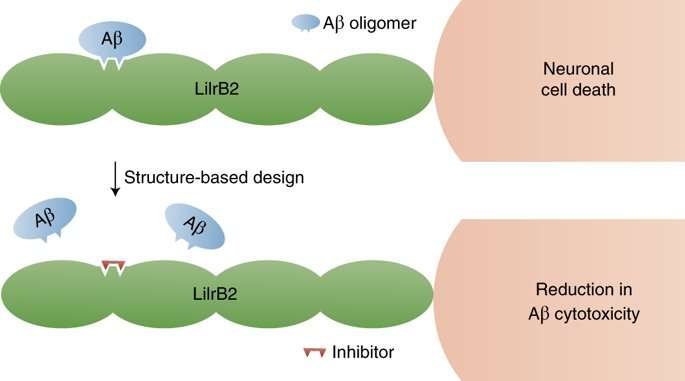Inhibiting the interaction between amyloid-β (Aβ) and a neuronal cell surface receptor, LilrB2, has been suggested as a potential route for treating Alzheimer’s disease. Supporting this approach, Alzheimer’s-like symptoms are reduced in mouse models following genetic depletion of the LilrB2 homologue. In its pathogenic, oligomeric state, Aβ binds to LilrB2, triggering a pathway to synaptic loss. Here we identify the LilrB2 binding moieties of Aβ (16KLVFFA21) and identify its binding site on LilrB2 from a crystal structure of LilrB2 immunoglobulin domains D1D2 complexed to small molecules that mimic phenylalanine residues. In this structure, we observed two pockets that can accommodate the phenylalanine side chains of KLVFFA. These pockets were confirmed to be 16KLVFFA21 binding sites by mutagenesis. Rosetta docking revealed a plausible geometry for the Aβ–LilrB2 complex and assisted with the structure-guided selection of small molecule inhibitors. These molecules inhibit Aβ–LilrB2 interactions in vitro and on the cell surface and reduce Aβ cytotoxicity, which suggests these inhibitors are potential therapeutic leads against Alzheimer’s disease.
Inhibiting amyloid-β cytotoxicity through its interaction with the cell surface receptor LilrB2 by structure-based design

TheDrugsLoveMe on October 23rd, 2018 at 17:53 UTC »
b-Amyloid plaques are the result of the disease, not the problem.
Clearing out b-Amyloid plaques is like cleaning up necrotic tissue and not doing anything about the gaping wound it left.
BDangle on October 23rd, 2018 at 17:09 UTC »
Anybody interested in the recent history of Alzheimer's research and just how badly anything we've tried against amyloid beta has done in the clinic should check out the long list of In The Pipeline articles on the subject (134!). It's a good review of the state of the field and just how much money we've thrown at this hypothesis for everything to have blown up in our faces.
http://blogs.sciencemag.org/pipeline/archives/category/alzheimers-disease
MightyQuinnW on October 23rd, 2018 at 14:32 UTC »
Before anyone gets too excited, there have been many attempts at beta-amyloid (BA) blocking drugs in the past. While they work to get rid of the plaques, the dementia remains. I believe it was Eli Lily that had a drug trial for one of these drugs 5-6 years ago that got rid of all the plaques but did nothing at slowing the progression of dementia.
Currently, the best looking candidate for treatments is the tau neurofibrillary tangles. But even those could just be a symptom and not a cause of the underlying condition.
Source: I'm a biomedical researcher.